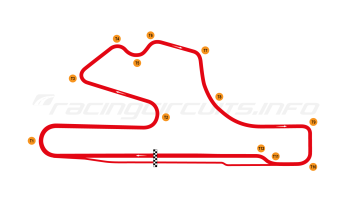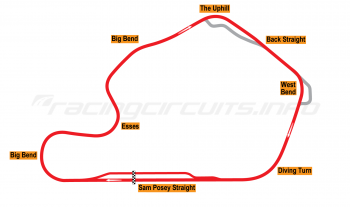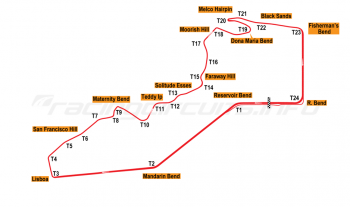Kristianstad
Circuit Overview
Kristianstad's closed road course was the home of the first World Championship Swedish Grand Prix for cars (albeit sportscars) and later hosted top level motorcycle racing, enjoying a brief moment in the spotlight before attention turned elsewhere.
Today, the public roads remain little altered, save for the insertion of a roundabout at the Frederickslund corner, while the Råbelövs estate section has returned to gravel and is now named Grand Prixvägen. A monument to the course was added in 1995 along this stretch to commemorate the 40th anniversary the first sportscar event.
Circuit History
The idea for races in the area came from the Kristianstad motorcycle club, who between 1949 and 1951 organised small scale races at Skepparslöv. However, club chairman Folke Nilsson and member Johan "Jocke" Lindström were keen to put on larger competitions, so the hunt was on for a new venue.
Soon, the possibility of organising races on roads around the Råbelöfs estate, located to the north of the city, were being examined. The estate owner, Douglas Kennedy, was in favour of the project but made a stipulation; if the races were to go ahead, an 'entertainment tax' should be levied against any tickets sold in order to provide funds to build a new retirement home in nearby Fjälkestad.
Half the Råbelövsbanan course was made up of public highway, but the racing circuit would utilise one of the tracks on the Råbelöv estate to link two portions of the circuit together. This was quickly upgraded into an acceptable road surface, albeit with an oiled gravel surface, while the rest of the course was asphalted. On September 14, 1952, the first 'Skåne' race was run on the track.
Status of the race grows
Over the next two years the events grew in importance and began to attract outside attention. The Royal Automobile Club visited to see if it might be a suitable venue for sportscar racing and soon the preparations were being made, with help from Prince Bertil, a keen auto enthusiast, who arranged contact with the likes of Mercedes-Benz, Aston Martin and Ferrari. The feedback was very positive about racing in Sweden, so the race was on to bring the circuit up to standard.
The track was widened throughout and the section through the Råbelöfs estate was asphalted and a pit and paddock area constructed at its midpoint, to where the start/finish would be re-located (previously it had been at the Fredrikslund end of the course). In addition, several temporary bridges and grandstands were put up and spectator banking laid out around the course. A PA system and race control tower were also installed.
With these improvements in place, Kristianstad was ready to host the Swedish Grand Prix in August 25, just a few months after the Le Mans tragedy. Some 80,000 spectators attended (a then-record for a Swedish sporting event) to seek works cars from Mercedes-Benz, Maserati, Ferrari and Aston Martin battle it out.
Unusually, the race used a Le Mans start but on the fast course proved to be something of a dull affair, with Stirling Moss for Mercedes leading lap one before being overtaken by teammate Juan Manuel Fangio on the second tour. He led the next 31 laps holding off Moss to the chequered flag. Only Fangio, Moss, Eugenio Castellotti (who came third for Ferrari), and Jean Behra (Maserati) were classified as finishers.
Nevertheless the race was judged a success (and the good folk of Fjälkestad were able to build their retirement home with the proceeds from the entertainment tax).
World Sportscar Championship debut
For the following year, it would go up a notch further, with its inclusion as the final round of the World Sportscar Championship.
The race drew a larger field, including works Ferrari and Maserati teams and Ecurie Ecosse's Le Mans-winning D-type Jaguars, and was run over 153 laps. It would prove to be an eventful race.
Peter Collins took an early lead in the Ferrari 290 MM, pursued by Moss in a Maserati 300S and Mike Hawthorne's Ferrari 860 Monza. At the first pit stop, Moss came out first. Behra (sharing the Moss 300S) suffered brake trouble and Olivier Gendebien (in Collins' Ferrari) had an oil leak, which led to a crash involving Gendebien's teammates Collins (taking over for Wolfgang von Trips) and Phil Hill (in the car started by Maurice Trintignant). This put the Ferrari shared between Castellotti and Fangio well ahead.
Moss took over the Maserati of Luigi Villoresi and Harry Schell, only for it to have trouble with its brakes as well. The car Moss started then caught fire in a pit stop debacle, while Castellotti's engine blew while in the lead. This gave victory to the Trintignant/Hill 250MM, followed home by von Trips/Collins in the second 250MM, and Hawthorne/Alfonso de Portago/Duncan Hamilton in an 860 Monza.
A final race for sports cars took place in 1957, this time over 6 hours rather than the previous 1000km. It was a much more straightforward affair, dominated by the Maserati 450S shared by Moss and Behra. The Ferrari 335S of Hill and Collins came home second, with Jo Bonnier/Giorgio Scarlatti/Harry Schell's Maserati 300s (which Moss also drove) in third.
Bike racing to the fore
That, as it turned out, was to be the end of the story for international sportscar racing, as the expense of putting on an event on this scale took its toll, and the local auto club threw in the towel. It was not however the end of racing altogether, as the Råbelövsbanan continued to host motorcycle racing with its annual TT races. In 1959 and again in 1961 they were counted as part of the FIM Road Racing World Championship and the Swedish Grand Prix banner was once again revived.
The 1959 race included 500cc, 350cc, 250cc and 125cc races, though only the latter three would count for the World Championship. Bob Brown took the top class, with John Surtees triumphing in the 350cc race, Gary Hocking taking the 250cc class and Tarquinio Provini winning the 125cc event.
After a gap of a year, the World Championship returned in 1961, this time with all races counting for points. Gary Hocking took the victory in the main 500cc class, Czech rider František Šťastný winning the 350cc event, Britain's Mike Hailwood the 250cc class and Swiss Luigi Taveri the junior class.
But that would turn out to be the last racing action on the Råbelövsbanan. The following year all of the equipment was auctioned off and the track was closed for good.
Circuit info
This is a historic circuit which is no longer in operation.
Rate This Circuit
Votes: 1099
Location Information
The Råbelövsbanan circuit was located at Kristianstad in Skåne county, Sweden. The nearest major airport is Ronneby Airport, just over an hour's drive east, which offers domestic flights, while Malmö Airport is around 90 minutes' drive to the south-west, offering international connections.
While the course itself is largely still as was, consisting of public roads, little remains to suggest this was ever a high-speed Grand Prix course, save for the 1995 monument on Grand Prixvägen. However, a small museum has been set up on the Råbelövs estate, adjacent to the course and is open by prior appointment. A celebration event of the anniversary of the 1959 motorcycle grand prix is planned for July 2019. Find out more at the museum website: kristianstad-gp.se/
Get your race tickets!
Brought to you with: 
We've teamed up with Motorsports Tickets to bring you the best deals for Formula One, MotoGP, Le Mans and more.









